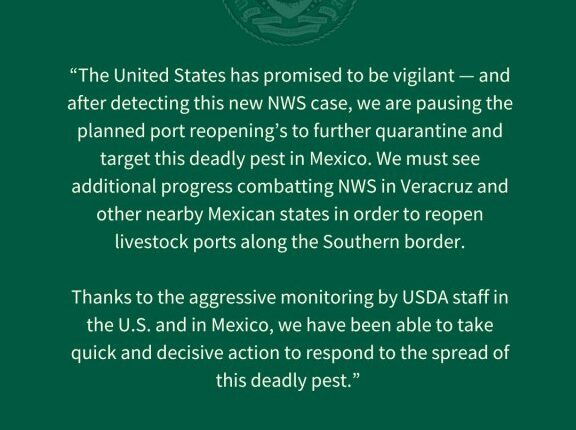Share this @internewscast.com
Editor’s note: This story has been updated to reflect a new suspension of Mexican cattle imports to the US
EL PASO, Texas (Border Report) — Agriculture Secretary Brooke Rollins has again suspended Mexican cattle imports to the United States due to renewed fears of New World screwworm infestation.
“I have ordered an immediate shutdown of live cattle, bison, and horse trade through the southern U.S.–Mexico border. This decisive action comes after Mexico confirmed another case of New World Screwworm in Veracruz,” Rollins said in a Wednesday evening message on X. The U.S. Agriculture Department “remains vigilant to ensure the protection of America’s livestock and food supply.”
Cattle imports from Sonora, Mexico, to Douglas, Ariz., had resumed this week, with the Columbus, New Mexico, port of entry scheduled to be the next to reopen to Mexican cattle exporters on Monday.
Rollins said she wants to see additional progress from Mexico in combatting the screwworm in Veracruz and other Mexican states.
“We are pausing the planned port reopening to further quarantine and target this deadly pest in Mexico. We must see additional progress […] in order to reopen livestock ports along the Southwest border,” she added.
Mexican President Claudia Sheinbaum Pardo on Thursday called the U.S. decision to pause Mexican livestock imports “totally exaggerated.”
“Yesterday, there was one case — one case — in Veracruz and is immediately being taken care of,” Sheinbaum said at her Thursday morning news conference in Mexico City broadcast on YouTube. “From our point of view, they made a totally exaggerated decision to close the border.”
She added Mexican animal health personnel has contained the animal, released sterile flies to mate with the flies that generate the screwworm larvae and that her country is out to prove to the U.S. through scientific methods that “everything is under control.”

—
EL PASO, Texas (Border Report) – A beef industry association is hailing the reopening of America’s borders to Mexican cattle exports.
Almost 900 head of cattle crossed the border into the U.S. from Agua Prieta, Mexico, at 3:50 p.m. on Monday at the Douglas (Arizona) Port of Entry, Mexican officials announced. It was the first such crossing since the United States closed the door to Mexican cattle in May due to fears over a screwworm infestation in Mexico.
The ban has kept more than 100,000 head of cattle from coming into the U.S. and resulted in $150 million in losses to ranchers in Mexico, according to Mexican sources.
Colin Woodall, CEO of the National Cattlemen’s Beef Association (NCBA), said the ban also has disrupted the American beef industry and emphasized the reopening of the border is being done with extreme precautions.
“Cattle moving through this port (Agua Prieta-Douglas) will go through a robust double inspection. Before entering the port, cattle will be inspected for wounds or other health conditions,” Woodall said in a statement. “Cattle will also receive anti-parasitic medication and be quarantined for three days before moving through the port.”
Once on U.S. soil, Mexican cattle again are inspected by veterinarians, he said.
The organization credited U.S. Secretary of Agriculture Brooke Rollins for holding Mexico accountable once a New World screwworm outbreak was detected. The insect is a parasitic fly whose larvae feeds on livestock, pets and humans.
Mexican officials said they expect their cattle to be admitted into the U.S. through Columbus, New Mexico, next week.
Border Report reached out to U.S. Customs and Border Protection for comment and was referred to the Agriculture Department.
A statement from the Agriculture Department said the two countries are cooperating in containing the spread of the insect plague and investing a combined $51 million in a sterile fly production facility in southern Mexico.
“While the Douglas, Ariz., port of entry presents the lowest risk based on the geography of Sonora and a long history of effective collaboration […] USDA intends to reopen additional ports in New Mexico and, if proven safe to do so, in Texas over the coming weeks,” the statement said.

The Columbus Port of Entry is to begin admitting cattle coming over from Palomas, Mexico on July 14, with the Santa Teresa (New Mexico) Port of Entry scheduled to do so on July 21, according to the statement. Del Rio and Laredo are to be the next to reopen, through the timeline may fluctuate.
Aware of the possible flux in the schedule, Chihuahua Gov. Maru Campos on Tuesday disclosed she met with a high-ranking USDA official in Washington, D.C., to brief him on her border state’s efforts to keep out the New World screwworm and ensure a timely reopening of cattle crossings.














